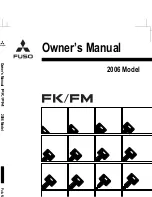
All trucks
Technical Handbook
Hydraulic Cylinders
Service
9279 02-09
Publ.
Gr. S.
3
70
Clean hydraulics
Hydraulic systems are extremely sensitive to impurities - a hy-
draulic system is just as sensitive as a diesel engine’s fuel sys-
tem, with its pumps, filters and lines.
It is therefore extremely important that hydraulic systems are kept
clean and free from impurities. A clean system means that there
are no impurities in the system, whether it be in the hydraulic flu-
id, component parts of the system or hydraulic lines and hoses.
By impurity, we refer to everything and anything that is not intend-
ed to be in the system:
z
solid particles such as dust, grit, threads of cotton waste,
flakes of rubber from hoses or seals, etc.
z
liquids
z
gasses
Possible sources of impurity
z
Existing impurities
– Casting sand, welding cinder, dust, water, etc., from com-
ponents, hydraulic lines and hoses.
z
Generated impurities
– Scaling. When particles that come between two moving
surfaces attach themselves to one of the surfaces and
thereafter act as a cutting surface to the opposite surface
where it cuts or grinds off material. The newly formed par-
ticles then harden and cause even more wear and tear as
they circulate in the system.
– Erosion
– Cutting or “cold welding”
– Cavitation, insufficient flow to pump
– Corrosion that generates particles
– Fatigue/wear and tear that generates particles
z
Accidentally added impurities
– During repair operations
– As a result of topping up with impure hydraulic fluid
z
Penetrative impurities
– Penetration via breather air to the hydraulic tank
– Penetration via the piston rod’s lubricating film
– Penetration through poorly sealed inspection hatches
– Condensation
– Penetration via rod seals
Solid particles
It is possible to see a particle of 40
µ
in size with the naked eye,
but not one of 10
µ.
(1
µ
= 1/1000 mm).
By comparison, a strand of human hair is approx.70
µ
thick. The
smallest particles are less than 25
µ
in size and are not visible to
the naked eye. If the number of small particles is sufficiently large,
they merely discolour the hydraulic fluid - by which time there are
far too many impurities in the system.
It is not, therefore, possible to judge, with the naked eye, whether
or not hydraulic fluid is sufficiently clean! A particle count using
special machinery or magnification equipment must be made to
establish the degree of impurity.
Solid impurities in hydraulic systems cause many different types
of problem. Large quantities of impurity dramatically reduce the
operative lifespan of the system. Hydraulic components break
down as a result of internal wear. Particles cause directional and
servo valves to seize, which, in turn, leads to the burning out of
the magnetic spools.
Summary of Contents for DCE80-100E
Page 2: ......
Page 30: ...DCE80 100E Technical Handbook Empty page 16 P Group 10 TDCE01 04GB ...
Page 43: ......
Page 44: ......
Page 45: ......
Page 46: ......
Page 47: ......
Page 48: ......
Page 49: ......
Page 50: ......
Page 51: ......
Page 52: ......
Page 53: ......
Page 54: ......
Page 55: ......
Page 56: ......
Page 57: ......
Page 58: ......
Page 59: ......
Page 60: ......
Page 61: ......
Page 62: ......
Page 63: ......
Page 64: ......
Page 65: ......
Page 66: ......
Page 67: ......
Page 68: ......
Page 69: ...A35093 0200 04 ...
Page 70: ......
Page 71: ......
Page 72: ......
Page 73: ......
Page 74: ......
Page 75: ......
Page 76: ......
Page 77: ......
Page 78: ......
Page 79: ......
Page 80: ......
Page 81: ......
Page 82: ......
Page 83: ......
Page 84: ......
Page 85: ......
Page 86: ......
Page 87: ......
Page 88: ......
Page 89: ......
Page 90: ......
Page 91: ......
Page 92: ......
Page 111: ......
Page 112: ......
Page 114: ...DCE80 100 Technical Handbook Contents 2 P Group 30 TDCE01 04GB ...
Page 131: ...DCE80 100E Technical Handbook 18 P Group 30 TDCE01 04GB Volvo TAD720VE ...
Page 162: ......
Page 235: ...DCE80 100E Technical Handbook Empty page 43 P Group 70 TDCE01 04GB ...
Page 242: ...DCE80 100E Technical Handbook Empty page 50 P Group 70 TDCE01 04GB ...
Page 243: ...4YFP RS 7YTTPIQIRX HVEYPMG PMRHIVW 8IGLRMGEP ERHFSSO PP 8VYGOW ...
Page 244: ......
Page 246: ......
Page 259: ......
Page 260: ... 4EVXIO SQTER EPQEV RHYWXVMIW 7ZIVMKI 7 0NYRKF 7 IHIR XIP JE OEPQEVMRH GSQ ...
Page 304: ...DCE80 100E Technical Handbook Empty page 2 P Group 90 TDCE01 04GB ...
Page 317: ...DCE80 100E Technical Handbook Empty page 15 P Group 90 TDCE01 04GB ...




































